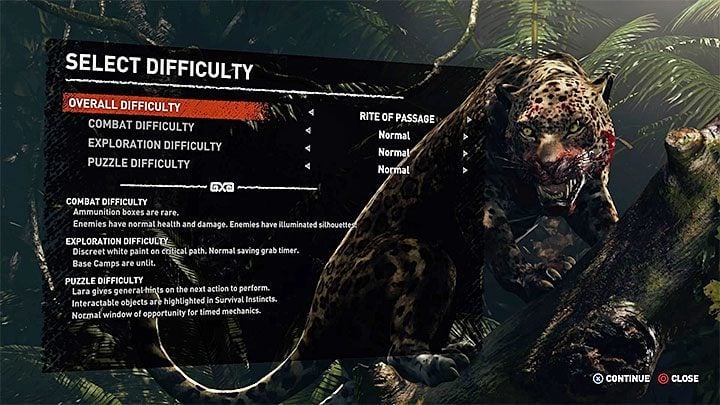Shadow of the Tomb Raider: Difficulty level
The section contains detailed info regarding the difficulty levels in the Shadow of the Tomb Raider. We've described all available difficulty levels and added some suggestions regarding choosing the optimal one.

Shadow of the Tomb Raider has an extensive system of difficulty:
- You can choose one of four main difficulty levels - easy, normal, hard and Deadly Obsession. If you want uniform difficulty across all categories, you can limit the choice to the main option.
- You can also separately change the difficulty of combat, exploration and puzzles. This is a very interesting option, one that has to be appreciated - it allows to further personalize the experience. For example, if you want to enjoy the exploration and puzzles, but you're not interested in challenging combat, you can lower the difficulty of fights, so that Lara will die less often.
Our recommendation for the first playthrough is the Rite of Passage setting:
- The enemies on normal difficulty can still pose a threat in combat, but you can use the Survival Instinct to locate them and heal Lara during combat, if such necessity arises.
- Normal difficulty of exploration doesn't hold your hand the entire time, but still allows you to use the Survival Instinct. That's particularly useful for location secrets and crafting materials.
- On normal puzzle difficulty, you can also expect Lara to provide you with limited tips. The game highlights interactive elements in the Survival Instinct mode, but the protagonist doesn't tell you exactly what to do with them and in what order.
The highest difficulty, Deadly Obsession, isn't a very good idea if you're completing the game for the first time. Ironically, it's not the challenging fights that will be the biggest problem. Finding interactive ledges, hooks and walls during exploration, as well as location secrets in the game is what's going to be the most difficult. Additionally, on Deadly Obsession dying also means getting back to the last camp, since standard checkpoints are not active. This makes things even more difficult. We recommend leaving this difficulty level for the second playthrough. The most important features of the last difficulty level:
- Saving the game is only possible in camps. This is one of the most significant changes. On lower difficulties, you will rarely visit camps. On the Deadly Obsession difficulty level, you need to use any opportunity to visit a camp - even if that means some backtracking in the largest locations. Also remember about collecting resources, as lighting bonfires isn't free.
- The climbing spots are not marked in any way. This is really annoying the first time you complete the game. If you've completed the game once, recognizing climbing spots will be a lot easier. In general, if you're not racing against time, you should make sure to plan each move well, especially if it consists of a few segments (jumping and using the line/axe, etc.)
- Survival Instinct isn't available. This can also be annoying if you want to find all secrets or many resources. Survival Instinct is very useful for that. Without it, you will have to do a lot of searching, or just focus on the main storyline and forget the rest.
- No health regeneration in combat. This is most notable when fighting wild animals and other enemies, who ignore sneaking. Focus on learning perfect dodges, as they will let you come out on top in most fights. However, when confronting the Trinity soldiers, try to stay hidden as long as possible and if you mess something up, try to escape and exit the line of sight of your enemies.
- No hints when solving puzzles. Another annoying element in the first playthrough. You can depend on this guide, however, since the actions that have to be completed are identical on all difficulties.
- Less time for reaction. That's a "global" handicap. That includes QTEs (for example wrestling with enemies) or climbing sections, when Lara sometimes loses her grips and the player has to react quickly in order for her not to fall into the abyss. Again, knowing the game is a huge advantage here, but you always need to be watchful and ready to react if need be.
An important detail is the fact that you can change the master difficulty, as well as the combat, exploration and puzzle difficulty at any time in the game - just pause the game and enter options, then select the Difficulty Level tab. Do that only if you really can't overcome some stage of the game. After adjusting the difficulty, defeating enemies will be easier and additional hints for Lara will become available.
Note: Obtaining some of the trophies in the game depends on the difficulty. Changing the main difficulty level during the game can rob you of some trophies. The only way of avoiding that (apart from not changing the difficulty at all) is changing only one of the additional difficulties (combat, exploration, puzzles) and leaving the master setting on the original value.
You are not permitted to copy any image, text or info from this page. This site is not associated with and/or endorsed by the developers and the publishers. All logos and images are copyrighted by their respective owners.
Copyright © 2000 - 2025 Webedia Polska SA for gamepressure.com, unofficial game guides, walkthroughs, secrets, game tips, maps & strategies for top games.
